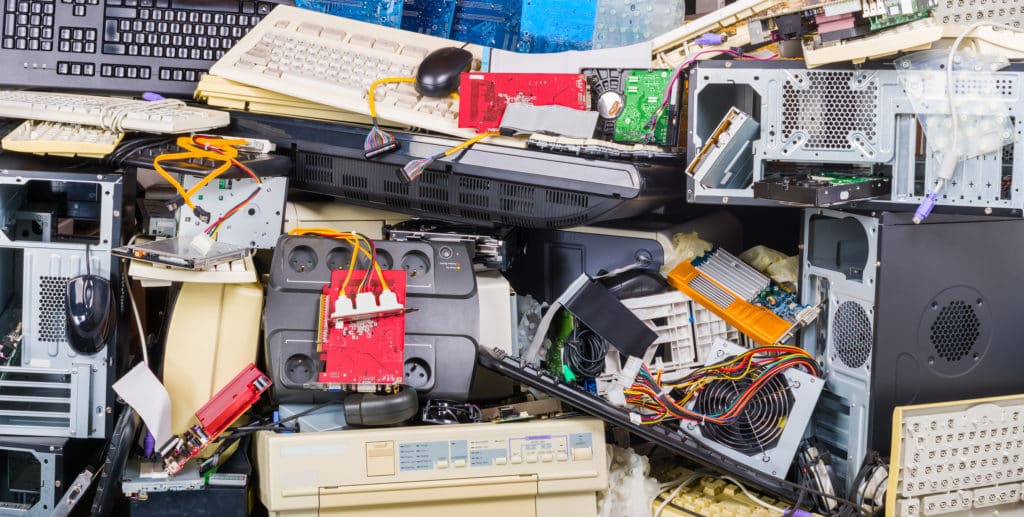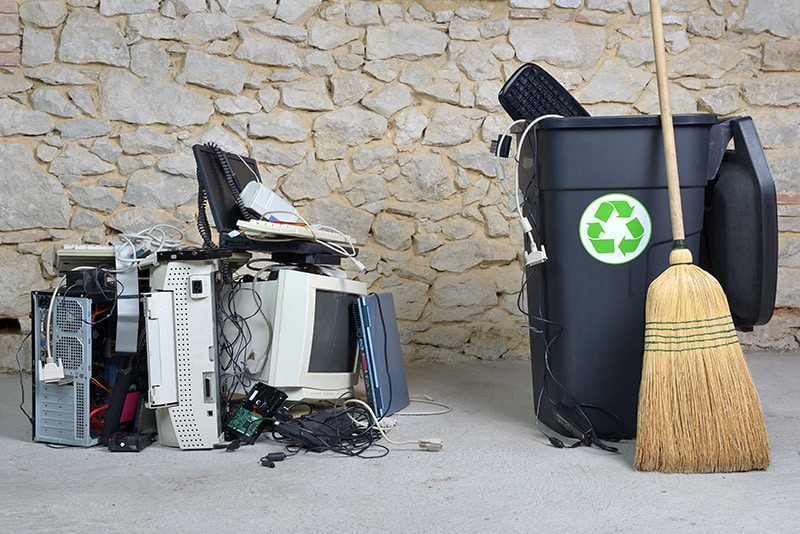Spring cleaning season is here, and recycling outdated electronics is a great way to empty drawers and make room in closets.
Broken tablets, old cell phones and obsolete desk top computers are big contributors to piles of clutter. Often people don’t know what to do with old electronics, so the unused devices continue to sit around and collect dust.
Below we’ve outlined why it’s important to properly dispose of old electronics, including recycling them.
Increase in Discarded Electronics
For the past several years there has been an increase in the number of electronic devices used in everyday life. At the same time, the “life span” of these devices has become shorter and shorter, as devices quickly become obsolete and de-supported when new versions of the device hit the market. This leaves consumers with growing piles of old electronics that they sometimes do not know how to handle. This trend was exacerbated during the COVID-19 pandemic, when even more people started using a growing number of devices for work, education and entertainment from home.
This growing use of electronics has a downside: a growing amount of electronic waste, or e-waste for short. E-waste refers to discarded electronics that find their way into the waste stream. It can include obvious items, like old cell phones, but also increasingly any household item, like exercise equipment, that runs like a computer.
To give a visual image of the increase, the amount of global electronic waste in 2019 weighed the equivalent of about 350 cruise ships. In 2022, it will weigh the equivalent of 375 cruise ships. According to the Waste Electrical and Electronic Equipment Forum (WEEE Forum), in 2021 there were 57.4 million tons of e-waste. Based on current trends, predictions are that total e-waste generated worldwide will reach 67 million tons by 2030, nearly doubling the output from 2014. According to a recent UN report, in 2019 only about 17.4 percent of discarded electronics were appropriately recycled. The United States that year produced about 6.92 million tons of e-waste, about 46 pounds per person.
Why Recycling Electronics is Important
The growing amount of e-waste and the challenges of handling it in the solid waste stream have made it an increasingly urgent environmental issue.
Here are some of the most significant reasons why recycling electronics is important.
- It’s critical to keep electronic waste out of landfills. The Environmental Protection Agency (EPA) has stated that e-waste is dangerous when disposed of improperly. Electronic devices are comprised of toxic substances and heavy metals. Materials such as chromium, cadmium, mercury and lead can leach into the soil contaminating the air and waterways, according to the EPA. The Agency estimates there are about 60 million tons of e-waste per year globally. Recycling this material will save landfill space. For these reasons, there are numerous state laws that now ban e-waste in landfills. Recycling this material not only keeps toxic substances out of landfills, but it also saves landfill space.
- Electronic products are comprised of valuable materials such as precious metals like gold, silver and platinum along with copper, aluminum, plastic and glass. Through the recycling process, these materials can be reclaimed. Most electronic devices are nearly 100 percent recyclable. It would be poor stewardship to landfill these materials. As an illustration, according to the EPA, if one million cell phones were recycled, it would yield:
- 35,274 pounds of copper
- 772 pounds of silver
- 75 pounds of gold
- 33 pounds of palladium
- Reclaiming valuable materials from the recycling process means there will be decreased demand for new raw materials. This will help conserve important natural resources that would otherwise have to be mined or newly manufactured, both of which require significantly more energy. According to the EPA, one metric ton of circuit boards contains 800 times the amount of gold mined from one metric ton of ore. A 2006 U.S. Geological Survey (USGS) estimated that recycling one million laptops saves the energy equivalent to the electricity used by more than 3,500 U.S. homes in a year.
- Using recycled material will also help reduce greenhouse gas emissions produced when manufacturing or processing new product known as “virgin material.” The more recycled material is available, the lower the demand for virgin material.
- Discarded electronic devices can also be kept out of the landfill if they are refurbished, reused and donated to a worthy cause. A quick Google search will provide a list of organizations in most areas that rebuild old electronics and provide them to those who otherwise would go without. “Reuse” is an important component of keeping material out of the waste stream. The EPA’s webpage has a listing of donation programs.
E-waste may make its way into scrapyards, mixed in with cars, old appliances and industrial scrap handled by the scrap metal recycling industry. Individual recyclers have different approaches for how to handle these items, but more progress is being made on how to extract valuable material and move these items through the recycling process. ScrapWare Corporation, of Rockville, MD, provides and services software supporting the scrap metal recycling industry and has observed the industry increasingly deal with electronics as part of the waste stream.
How to Recycle Electronics
Before donating or recycling used electronics consider upgrading hardware or software instead of buying something brand new. Once you decide to buy new electronics, make sure you delete all personal information from your old device. The EPA recommends removing batteries from your electronics, as they may need to be recycled separately. Remember that lithium-ion batteries should never go into household garbage or curbside recycling bins where they pose a serious fire hazard.

Do a search in your area for places that recycle electronics. Several electronics retailers such as Best Buy and Staples accept discarded devices for recycling. Not only do they accept recyclables, they will sometimes pay customers to drop them off. Staples website, for example, states they will offer rewards cash for customers recycling ink and toner cartridges. Best Buy’s website says customers can bring in three items per day to be recycled for free, and they have a haul away service for larger electronic items.
Manufacturers such as Apple, Samsung, Microsoft and Dell will also accept their old products to recycle. Some government agencies and environmental groups have established databases to help consumers find a recycling location nearby. The website Earth911.com is one example of an extensive recycling database. Database users enter the device they want recycled and their zip code and a list of potential recycling sites are displayed.
The EPA website links to a current list of places for electronics recycling at:
epa.gov/recycle/electronics-donation-and-recycling
Municipalities and manufacturers are also playing a role in managing recycling e-waste. When state and local governments evaluate a recycling program, more are considering how to handle e-waste as part of their waste disposal system. According to the National Conference of State Legislatures, 25 states and the District of Columbia have laws regulating e-waste. On the manufacturing end, products such as mobile phones have been designed to become obsolete faster and faster, however, manufacturers are now being encouraged to develop products with longer life spans. More electronics manufacturers are also looking at design elements that will make devices easier to disassemble so that the valuable materials can be more easily extracted and recycled.
Advances in Recycling Electronics
In the United States, entrepreneurs, researchers and recyclers are pursuing efforts using artificial intelligence (AI) in emerging technology to make electronics recycling safe and affordable.
Recyclers have made strides with innovations to reclaim recyclable material with robots that can safely break open and separate electronics, but these efforts are not yet widely used across the country. Pursuing efforts to use more AI to recycle e-waste might be a game changer. The Wall Street Journal reported last year one U.S. tech start-up is doing just that. Massachusetts-based Phuc Labs has developed a process they call “Vision Valve” using AI to recycle electronic waste more efficiently.
The concept behind Vision Valve is to put e-waste in a stream of liquid and separate contaminants out particle by particle. This starts like other recycling processes, chopping up debris from crushed discarded electronics. From there, Phuc Labs suspends the particles in water and sends it down tiny tubes. A camera captures its passage through the system at 100 frames per second. Once photographed, a computer trained to identify the particles analyzes each frame and directs the particles accordingly until all the valuable particles have been separated out. According to the Journal report, filtration of this nature would be impossible without AI machine vision systems. This type of AI is already widely used in facial recognition on smart phones and autonomous driving systems.
According to the technology website, The Verge, last year the Department of Energy supported research to develop software allowing robots to identify different types of smartphones in the waste stream. The robots would then remove their batteries and extract the valuable components. The software would allow the robots to identify the phones and look up the phones’ internal anatomy. The end goal, according to researchers, will be to have a smartphone-stripping robot that can be inserted into any e-waste recycling operation.
As companies, researchers and municipalities continue to deal with e-waste, we can expect more innovation using AI to try to make e-waste recycling efforts safe and affordable. In the meantime, don’t let another year go by before you get your old electronics out of the closet and to a place where they can be recycled. This spring-cleaning season is a great time for your electronics recycling.
About ScrapWare Corporation: Since 1989, Rockville, Maryland-based ScrapWare Corporation has been the software of choice for the recycling industry. Its ease of installation and simplicity saves users time and money while helping them achieve compliance and maintain accurate business insights. With state-of-the-art functionality that‘s tailored to each organization’s unique requirements, ScrapWare is an advanced dynamic software solution that alleviates the most pressing recycling industry worries. For more information, please call (301) 517-8500 or visit https://www.scrapware.com/.

